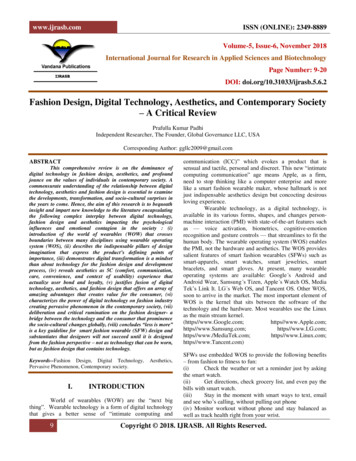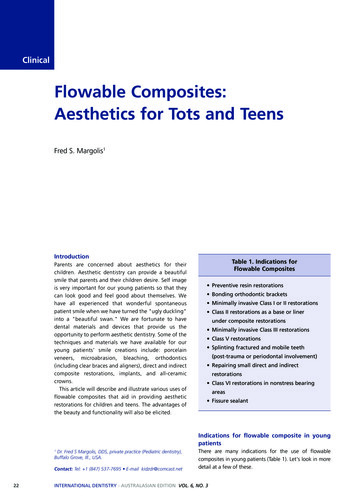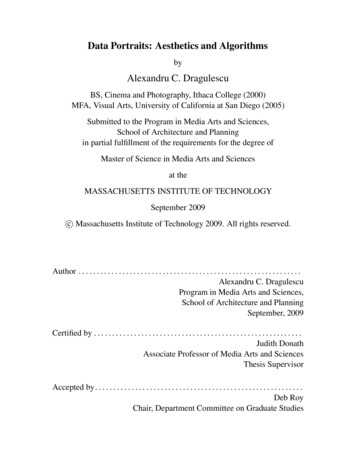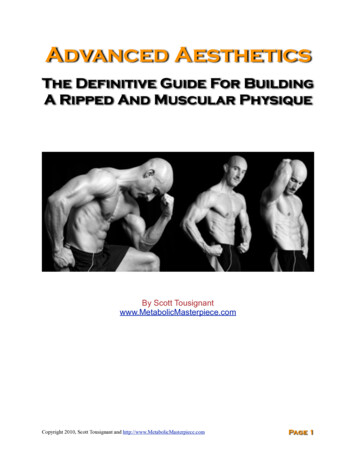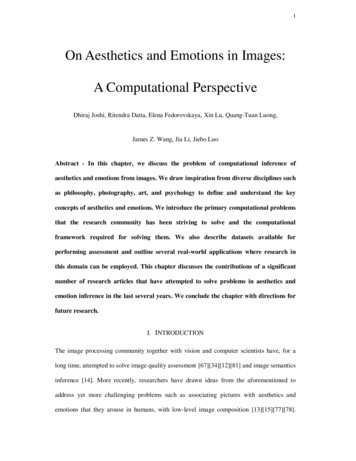
Transcription
1On Aesthetics and Emotions in Images:A Computational PerspectiveDhiraj Joshi, Ritendra Datta, Elena Fedorovskaya, Xin Lu, Quang-Tuan Luong,James Z. Wang, Jia Li, Jiebo LuoAbstract - In this chapter, we discuss the problem of computational inference ofaesthetics and emotions from images. We draw inspiration from diverse disciplines suchas philosophy, photography, art, and psychology to define and understand the keyconcepts of aesthetics and emotions. We introduce the primary computational problemsthat the research community has been striving to solve and the computationalframework required for solving them. We also describe datasets available forperforming assessment and outline several real-world applications where research inthis domain can be employed. This chapter discusses the contributions of a significantnumber of research articles that have attempted to solve problems in aesthetics andemotion inference in the last several years. We conclude the chapter with directions forfuture research.I. INTRODUCTIONThe image processing community together with vision and computer scientists have, for along time, attempted to solve image quality assessment [67][34][12][81] and image semanticsinference [14]. More recently, researchers have drawn ideas from the aforementioned toaddress yet more challenging problems such as associating pictures with aesthetics andemotions that they arouse in humans, with low-level image composition [13][15][77][78].
/100high scoremedium scorelow scoreFigure 1: Pictures with high, medium, and low aesthetics scores fromACQUINE, an online automatic photo aesthetics engine.Fig. 1 shows an example of state-of-the-art automatic aesthetics assessment. Becauseemotions and aesthetics also bear high-level semantics, it is not a surprise that research inthese areas is heavily intertwined. Besides, researchers in aesthetic quality inference alsoneed to understand and consider human subjectivity and the context in which the emotion oraesthetics is perceived. As a result, ties between computational image analysis andpsychology, study of beauty [41][58] and aesthetics in visual art, including photography, arealso natural and essential.Despite the challenges, various research attempts have been made and are increasinglybeing made to address basic understanding and solve various sub-problems under theumbrella of aesthetics, mood, and emotion inference in pictures. The potential beneficiariesof this research include general consumers, media management vendors, photographers, andpeople who work with art. Good shots or photo opportunities may be recommended to
3PleasingBoringSurprisingFigure 2: Pictures and emotions rated by users from ALIPR.com, aresearch site for machine-assisted image tagging.consumers; media personnel can be assisted with good images for illustration while interiorand healthcare designers can be helped with more appropriate visual design items. Pictureeditors and photographers can make use of automated aesthetics feedback when selectingphotos for photo-clubs, competitions, portfolio reviews, or workshops. Similarly, from apublication perspective, a museum curator may be interested in assessing if an artwork isenjoyable by a majority of the people. Techniques that study similarities and differencesbetween artists and artwork at the aesthetic level could be of value to art historians.We strongly believe that computational models of aesthetics and emotions may be able toassist in such expert decision making and perhaps with time and feedback learn to adapt toexpert opinion better (Fig. 2 shows user-rated emotions under the framework of web imagesearch that can potentially be used for learning emotional models). Computational aestheticsdoes not intend to obviate the need for expert opinion. On the other hand, automated methods
4would strive toward becoming useful suggestion systems for experts that can be personalized(to one or few experts) and improved with feedback over time (as also expressed in [71]).In this chapter, we have attempted to introduce components that are essential for thebroader research community to get involved and excited about this field of study. In SectionII, we discuss aesthetics with respect to philosophy, photography, art, and psychology.Section III introduces a wide spectrum of research problems that have been attempted incomputational aesthetics and emotions. The computational framework in the form of featureextraction, representation, and modeling is the topic of Section IV. Datasets and otherresources available for aesthetics and emotions research are reviewed in Section V whileSection VI takes a futuristic stance and discusses potential research directions andapplications.II. BACKGROUNDThe word “aesthetics” originates from the Greek word aisthētikos sensitive, derived fromaisthanesthai "to perceive, to feel". The American Heritage Dictionary of the EnglishLanguage provides the following currently used definitions of aesthetics:1. The branch of philosophy that deals with the nature and expression of beauty, as inthe fine arts. In Kantian philosophy, the branch of metaphysics concerned with thelaws of perception;2. The study of the psychological responses to beauty and artistic experiences;3. A conception of what is artistically valid or beautiful;4. An artistically beautiful or pleasing appearance.Philosophical studies have resulted in formation of two views on beauty and aesthetics: thefirst view considers aesthetic values to be objectively existing and universal, while the secondposition treats beauty as a subjective phenomenon, depending on the attitude of the observer.
5A. A Perspective on PhotographsWhile aesthetics can be colloquially interpreted as a seemingly simple matter as to what isbeautiful, few can meaningfully articulate the definition of aesthetics or how to achieve ahigh level of aesthetic quality in photographs. For several years, Photo.net has been a placefor photographers to rate the photos of peers [96]. Here a photo is rated along twodimensions, aesthetics and originality, each with a score between one and seven. Examplereasons for a high rating include “looks good, attracts/holds attention, interestingcomposition, great use of color, (if photo journalism) drama, humor, and impact, and (ifsports) peak moment, struggle of athlete.”Ideas of aesthetics emerged in photography around the late 19th century with a movementcalled Pictorialism. Because photography was a relatively new art at that time, the Pictorialistphotographers drew inspiration from paintings and etchings to the extent of emulating themdirectly. Photographers used techniques such as soft focus, special filters, lens coatings,special darkroom processing, and printing to achieve desired artistic effects in their pictures.By around 1915, the widespread cultural movement of Modernism had begun to affect thephotographic circles. In Modernism, ideas such as formal purity, medium specificity, andoriginality of art became paramount. Post-modernism rejected ideas of objective truth in art.Sharp classifications into high-art and low-art became defunct.In spite of these differing factors, certain patterns stand out with respect to photographicaesthetics. This is especially true in certain domains of photography. For example, in naturephotography, it can be demonstrated that the appreciation of striking scenery is universal.Nature photographers often share common techniques or rules of thumb in their choices ofcolors, tonality, lighting, focus, content, vantage point, and composition. One such acceptedrule being that the purer the primary colors, red (sunset, flowers), green (trees, grass), and
6blue (sky), the more striking the scenery is to viewers. In terms of composition, there areagain common and not-so-common theories or rules. The rule of thirds is the most widelyknown which states that the most important part of the image is not the exact center of theimage but rather at the one third and two third lines (both horizontal and vertical), and theirfour intersections. A less common rule in nature photography is to use diagonal lines (such asa railway, a line of trees, a river, or a trail) or converging lines for the main objects of interestto draw the attention of the human eyes. Another composition rule is to frame the shot so thatthere are interesting objects in both the close-up foreground and the far-away background.However, great photographers often have the talents to know when to break these rules to bemore creative. Ansel Adams said, “There are no rules for good photographs, there are onlygood photographs.”B. A Perspective on PaintingsPainters in general have a much greater freedom to play with the palette, the canvas, and thebrush to capture the world and its various seasons, cultures, and moods. Photographs at largerepresent true physical constructs of nature (although film photographers sometimesaesthetically enhanced their photos by dodging and burning). Artists, on the other hand, havealways used nature as a base or as a “teacher” to create works that reflected their feelings,emotions, and beliefs.
7Figure 3: Paintings by Van Gogh (top-left) Avenue of Poplars in Autumn, (topright) Still Life: Vase with Gladioli, (bottom-left) Willows at Sunset,(bottom-right) Automatically extracted brushstrokes for Willows atSunset. Notice the widely different nature and use of colors in thepaintings (courtesy – Top images: Van Gogh Museum Amsterdam(Vincent van Gogh Foundation). Bottom images: Kröller-Müller Museumand James Z. Wang Research Group at Penn State.).History abounds with many influential art movements that dominated the world art scenefor certain periods of time and then faded away, making room for newer ideas. It would notbe incorrect to say that most art-movements (sometimes individual artists) definedcharacteristic painting styles that became the primary determinants of art aesthetics of thetime. One of the key movements of Western art, Impressionism, started in late 19th centurywith Claude Monet’s masterpiece “Impression, Sunrise, 1872.” Impressionist artists focusedon ordinary subject matter, painted outdoors, used visible brush-strokes, and employed colors
8to emphasize light and its effect on their subjects. A derivative movement, Pointillism, waspioneered by Georges Seurat, who mastered the art of using colored dots as building blocksfor paintings. Early 20th century Post-impressionist artists digressed from the past andintroduced a personal touch to their world depictions giving expressive effects to theirpaintings. Van Gogh is especially known for his bold and forceful use of colors in order toexpress his artistic ideas (Fig. 3). Van Gogh also developed a bold style of brush strokes, anunderstanding of which can perhaps offer newer perspectives into understanding his workand that of his contemporaries (Fig. 3 shows an example of automatic brushstroke extractionresearch presented in [32]).With the rise of Expressionism, blending of reality and artists’ emotions became vogue.Expressionist artists freely distorted reality into a personal emotional expression. Abstractexpressionism, a post World War II phenomenon, put America in the center stage of art forthe first time in history. Intense personal expression combined with spontaneity and hints ofsubconscious and surreal emotion gave a strikingly new meaning to art and possibilities ofcreation became virtually unbounded. Although there has recently been some work oninferring aesthetics in paintings [44][75][76], such work is usually limited to a small-scalespecific experimental setup. One such work [76] scientifically examines the works ofMondrian and Pollock, two stalwarts of modern art with drastically distinct styles (the formerattempting to achieve spiritual harmony in art while the latter known for mixing sand, brokenglass, and paint and his unconventional paint drip technique).C. Aesthetics, Emotions, and PsychologyThere are several main areas and directions of experimental research, related to psychology,which focus on art and aesthetics: experimental aesthetics (psychology of aesthetics),
9psychology of art, and neuroasthetics. These fields are interdisciplinary and draw onknowledge in other related disciplines and branches of psychology.Experimental aesthetics is one of the oldest branches of experimental psychology, whichofficially begins with the publishing of Fechner’s Zur experimentalen Aesthetik in 1871, andVorschule der Aesthetick in 1876 [23][24]. Fechner suggested three methods for use inexperimental aesthetics, (i) including the method of choice where subjects are asked tocompare objects with respect to their pleasingness; (ii) the method of production, wheresubjects are required to produce an object that conforms to their tastes by drawing or otheractions; and (iii) the method of use, which analyzes works of art and other objects on theassumption that their common characteristics are those that are most approved in society.Developments in other areas of psychology of the early decades of the twentieth centurycontributed to the psychology of aesthetics. Gestalt psychology produced influential ideassuch as the concept of goodness of patterns and configurations emphasizing regularity,symmetry, simplicity, and closure [38]. In the 1970s Berlyne revolutionized the field ofexperimental aesthetics by bringing to the forefront of the investigation psychophysiologicalfactors and mechanisms underlying aesthetic behavior. In his seminal book “Aesthetics andPsychobiology” (1971) [3], Berlyne formulated several theoretically and experimentallysubstantiated ideas that helped shape modern experimental research in aesthetics into thescience of aesthetics [57].Berlyne’s ideas and research directions together with the advances in understanding ofneural mechanisms of perception, cognition, and emotion obtained in psychology [70],psychophysiology, and neuroscience and facilitated by the modern imaging techniques led tothe emergence of neuroaesthetics in the 1990s [33][37][60][89]. Recent studies associatedwith the Processing Fluency Theory by Reber et al. in [62] suggest that aesthetic experience
10is a function of the perceiver’s processing dynamics: the more fluently the perceiver canprocess an image, the more positive is their aesthetic response.III. KEY PROBLEMS IN AESTHETICS AND EMOTIONS INFERENCEMany different problems have been studied under the umbrella of aesthetics and emotionsevoked from pictures and paintings. While different problem formulations are focused onachieving different high-level goals, the underlying process is always aimed at modeling anappeal, aesthetics, or emotional response that a picture, a collection of pictures, or a piece ofart evokes in people. We divide this discussion into two sections. The first section is devotedto mathematically formulating the core aesthetics and emotions prediction problems. In thesecond section, we discuss some problems that are directly or indirectly derived from the coreaesthetics or emotions prediction problems in their scope or application.A. Core Problems1) Aesthetics PredictionWe assume that an imagehas associated with it a true aesthetics measure, which is theasymptotic average if the entire population rated it. The average over the sizeratings, given bywhereis thesample ofis an estimator for the population parameterrating given to image . Intuitively, a larger,gives a better estimate. Aformulation for aesthetics score prediction is therefore to infer the value ofby analyzingthe content of image , which is a direct emulation of humans in the photo rating process. Thislends itself naturally to a regression setting, whereby some abstractions of visual features actas predictor variables and the estimator foris the dependent variable. An attempt atregression-based score prediction has been reported in [13] where the quality of scoreprediction is assessed in the form of rate or distribution of error.
11It has been observed both in [13] and [34] that score prediction is a highly challengingproblem, mainly due to noise in user ratings. To make the problem more solvable, theregression problem is changed to one of classification, by thresholding the average scores tocreate high- vs. low-quality image classes [13], or professional vs. snapshot image classes[34]. An easier problem, but one of practical significance, is that of selecting a fewrepresentative high-quality or highly aesthetic photographs from a large collection. In thiscase, it is important to ensure that most of the selected images are of high quality even thoughmany of those not selected may be of high quality as well. An attempt at this problem [15]has proven to be more successful than the general classification problem. The classificationproblem solutions can be evaluated by standard accuracy measures [13][34]. Conversely, theselection of high-quality photos needs only to maximize the precision in high quality withinthe top few photos, with recall being less critical.Discussion: An aesthetics score can potentially capture finer gradations of aesthetics valuesand hence a score predictor would be more valuable than an aesthetics class predictor.However, score prediction requires training examples from all spectrums of scores in thedesired range and hence the learning problem is much more complex than the class prediction(which can typically be translated into a multi-class classification problem well known inmachine learning). Opportunities lie in learning and predicting “distributions of aestheticsvalues” instead of singular aesthetics classes or scores. Scores or values being ordinal ratherthan categorical in nature can be mapped to the real number space. Learning distribution ofaesthetics on a per image basis can throw useful light on human perception and helpalgorithmically segment people into “perception categories.” Such research can also helpcharacterize various gradations of “artist aesthetics” and “consumer aesthetics” and studyhow they influence one another perhaps over time. An effort in this direction has been madein [83]
122) Emotion PredictionIf we group emotions that natural images arouse into categories such as “pleasing,” “boring,”and “irritating,” then emotion prediction can be conceived as a multiclass classificationproblem [86]. Consider that there areemotion categories, and people select one or more ofthese categories for each image. If an imagereceives votes in the proportion,then two possible questions arise:Most Dominant Emotion: We wish to predict, for an image I, the most voted emotioncategory, i.e.,clear dominance of. The problem is only meaningful when there isover others.Emotion Distribution: We wish to predict the distribution of votes (or an approximation) thatan image receives from users, i.e.,, which is well suited when images arefuzzily associated with multiple emotions.The “most dominant emotion” problem is assessed like a standard multiclass classificationproblem. For “emotion distribution,” assessment requires a measure of similarity betweendiscrete distributions, for which Kullback-Leibler (KL) divergence is a possible choice.Discussion: While the most dominant emotion prediction translates the problem into amulticlass classification problem that has successfully been attempted in machine learning,emotion distribution would be more realistic from a human standpoint. Human beings rarelyassociate definitive emotions with pictures. In fact, it is believed that great works of art evokea “mix of emotions” leaving little space for emotional purity, clarity, or consistency.However, learning a distribution of emotions from pictures requires a large and reliableemotion ground truth dataset. At the same time, emotional categories are not completelyindependent (e.g., there may be correlations between “boring” and “irritating”). One of thekey open issues in this problem is settling upon a set of plausible emotions that areexperienced by human beings. Opportunities also lie in attempting to explore the
13relationships (both causal and semantic) between human emotions and leveraging them forprediction.B. Associated Problems1) Image Appeal, Interestingness, and Personal ValueOften, the appeal that a picture makes on a person or a group of people may depend onfactors not easily describable by low-level features or even image content as a whole. Suchfactors could be socio-cultural, demographic, purely personal (e.g., “a grandfather’s lastpicture”), or influenced by important events, vogues, fads, or popular culture (e.g., “acelebrity wedding picture”). In the age of ever-evolving social networks, “appeal” can also bethought of as being continually reinforced within a social media framework. Facebook allowsusers to “like” pictures, and it is not unusual to find “liking” patterns governed by one’sfriends and network (e.g., a person is likely to “like” a picture in Facebook if many of herfriends have done so). Flickr’s interestingness attribute is another example of a communitydriven measure of appeal based on user-judged content and community reinforcement.A user study to determine factors that would prevent people from including a picture intheir albums was reported in [65]. Factors such as “not an interesting subject,” “a duplicatepicture,” “occlusion,” or “unpleasant expression” were found to dominate the list. Attributingmultidimensional image value indexes (IVI) to pictures based on their technical and aestheticqualities and social relevance has been proposed in [47]. While technical and aesthetic IVIsare driven by learned models based on low-level image information, an intuitive social IVImethodology can be adherence to social rules learned jointly from users’ personal collectionsand social structure. An example could be to give higher weights to immediate familymembers than cousins, friends, and neighbors in judging a picture’s worth [47].Discussion: While a personal or situational appeal or value would be of greater interest to anon-specialist user, generic models for appeal may be even more short-lived than foraesthetics. In order to make an impact, the problems within this category must be carefully
14tailored toward learning personal or situational preferences. From an algorithmic perspective,total dependence on visual characteristics, for modeling and predicting consumer appeal, is apoor choice and it is desirable to employ image metadata such as tags, geographicalinformation, time, and date. Inferring relationships between people based on the faces andtheir relative geometric arrangements in photos could also be a very useful exercise [27].2) Aesthetics and Emotions in Artwork CharacterizationArtistic use of paint and brush can evoke a myriad of emotions among people. These are toolsthat artists employ to convey their ideas and feelings visually, semantically, or symbolically.Thus they form an important part of the study of aesthetics and emotions as a whole. Paintingstyles and brushstrokes are best understood and explained by art connoisseurs. However,research in the last decade has shown that models built using low-level visual features can beuseful aids to characterize genres and painting styles or for retrieval from large digitized artgalleries [7][8] [21][39][40][64]. In an effort to encourage computational efforts to analyzeartwork, the Van Gogh and Kröller-Müller museums in the Netherlands have made 101 highresolution grayscale scans of paintings available to several research groups [32].Brushstrokes provide reliable modeling information for certain types of paintings that donot have colors. In [45], mixtures of stochastic models have been used to model an artist’ssignature brushstrokes and painting styles. The research provides a useful methodology forart historians who study connections among artists or periods in the history of art. Anotherimportant formulation of this characterization problem has been discussed in [6]. The workconstructs an artists’ graph wherein the edges between two nodes are representative of somemeasure of collective similarities between paintings of the two artists (and in turn influenceof artists on one another). A valuable problem to the commercial art community is to modeland predict a common-man’s perception and appreciation of art as opposed to that of artconnoisseurs [44] .
15An interesting application of facial expression recognition technology has been shown to bethe decoding of the expression of portraits such as the Mona Lisa to get an insight into theartists’ minds [98]. Understanding the emotions that paintings arouse in humans is yetanother aspect of this research. A method that categorizes emotions in art based on groundtruth from psychological studies has been described in [86] wherein training is performedusing a well-known image dataset in psychology while the approach is demonstrated on artmasterpieces.Discussion: Problems discussed within this category range from learning nuances ofbrushstrokes to emotions that artworks arouse in humans and even emotions depicted in theartworks themselves. This is a challenging area and the research is expected to be helpful tocurators of art as well as to commercial art vendors. However, contribution here would inmost scenarios benefit from direct inputs of art experts or artists themselves. As most of thepaintings that are available in museums today were done before the 20th century, obtainingfirst-hand inputs from artists is impossible. However, such research aims to build healthycollaborations between the art and computer science research communities, some of whichare already evident today [32].3) Aesthetics, Emotions, and AttractivenessAnother manifestation of emotional response is attraction among human beings especially tomembers of the opposite sex. While the psychology of attraction may be multidimensional,an important aspect of attraction is the perception of a human face as beautiful.Understanding beauty has been an important discipline in experimental psychology [79].Traditionally, beauty was synonymous with perfection and hence symmetric or perfectlyformed faces were considered attractive. In later years, psychologists conducted studies toindicate that subtle asymmetry in faces is perceived as beautiful [66][74][88]. Therefore, itseems that computer vision research on asymmetry in faces, such as [46], can be integrated
16with psychological theories to computationally understand the dynamics of attractiveness.Another perspective is the theory that facial expression can affect the degree of attractivenessof a face [18]. The cited work uses advanced MRI techniques to study the neural response ofthe human brain to a smile. The current availability of Web resources has been leveraged toformulate judging facial attractiveness as a machine learning problem [17].Discussion: Research in this area is tied to work in face and facial expression recognition.There are controversial aspects of this research in that it tries to prototype attraction or beautyby visual features. While it is approached here purely from a research perspective, theovertones of the research may not be well accepted by the community at large. Beauty andattraction are personal things and many people would dislike it to be rated on a scale. Itshould also be noted that beauty contests also assess the complete personality of participantsand do not judge merely by visual aspects.4) Aesthetics, Emotions, and Image RetrievalWhile image retrieval largely involves generic semantics modeling, certain interestingoffshoots that involve feedback, personalization, and emotions in image retrieval have alsobeen studied [80]. Human factors such as mentioned above largely provide a way to rerankimages or search among equals for matches closer to the heart of a user. In [4], an imagefiltering system is described that uses the Kansei methodology to associate low-level imagefeatures with human feelings and impressions. Another work [22] attempts to model thetarget image within the mind of a user using relevance feedback to learn a distribution overthe image database. In a recent work, the attractiveness of images is used to enhance theperformance of Web image search engine (in terms of the online ranking, interactive reranking, and offline index selection) in [28]. Along similar lines, [63] integrates semantic,aesthetic, and affective features to achieve significant improvement for the task of scenerecognition on various diverse and large-scale datasets.
17Discussion: Of late there is emphasis on human centered multimedia information processing,which also touches aspects of retrieval. However, such research is not easily evaluable orverifiable as again the level of subjectivity is very high. One potential research direction is toassess the tradeoff between personalization of results and speed of retrieval.IV. COMPUTATIONAL FRAMEWORKFrom a computational perspective, we need to consider steps that are necessary to obtain aprediction (some function of the aesthetics or emotional response) from an input image. Wedivide this discussion into two distinct sections, feature representation and modeling andlearning, and elucidate how researchers have approached each of these computational aspectswith respect to the current field. However, before moving forward, it is important tounderstand and appreciate certain inherent gaps when any image understanding problem isaddressed in a computational way. Smeulders et. al. introduced the term semantic gap in theirpioneering survey of image retrieval to summarize the technical limitations of imageunderstanding [69]. In an analogous fashion, the technical challenge in automatic inference ofaesthetics is defined in [16] as the aesthetics gap, as follows: The aesthetics gap is the lack ofcoincidence between the information that one can extract from low-level visual data (i.e.,pixels in
expressionism, a post World War II phenomenon, put America in the center stage of art for the first time in history. Intense personal expression combined with spontaneity and hints of subconscious and surreal emotion gave a strikingly new meaning to art

